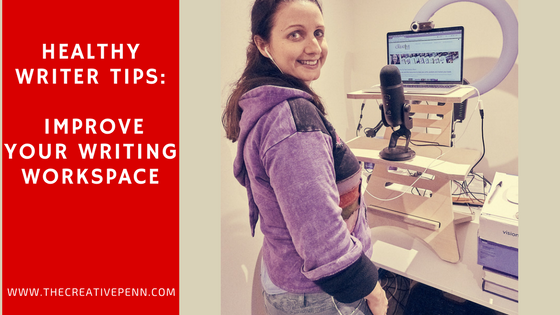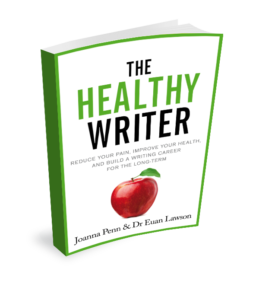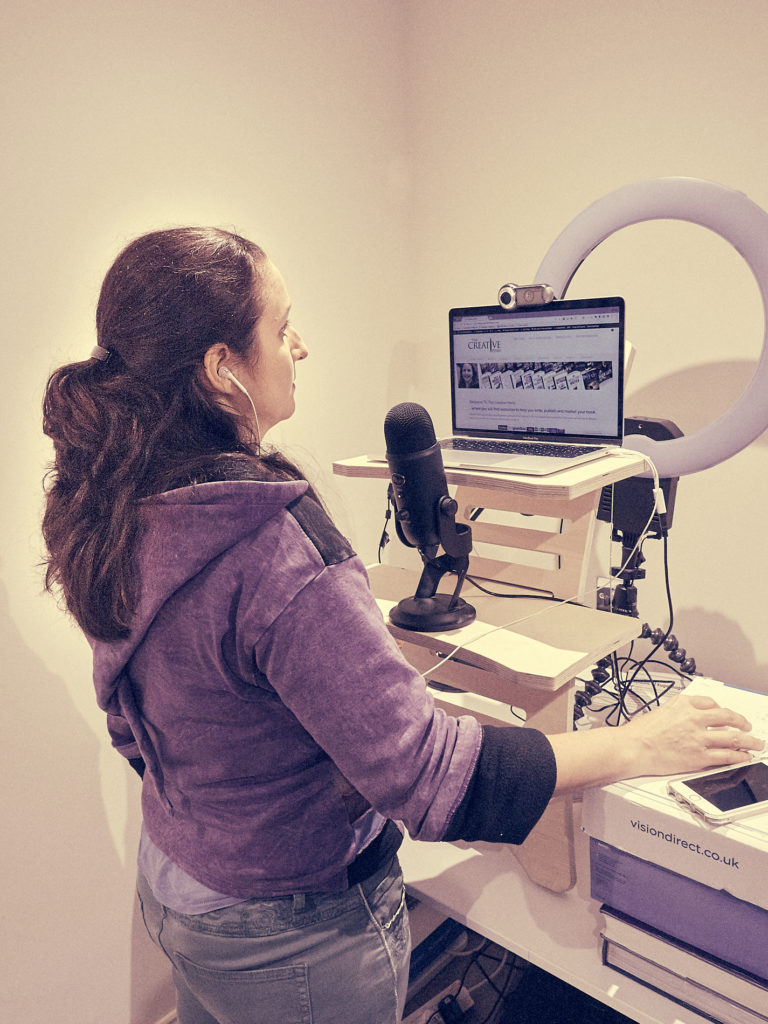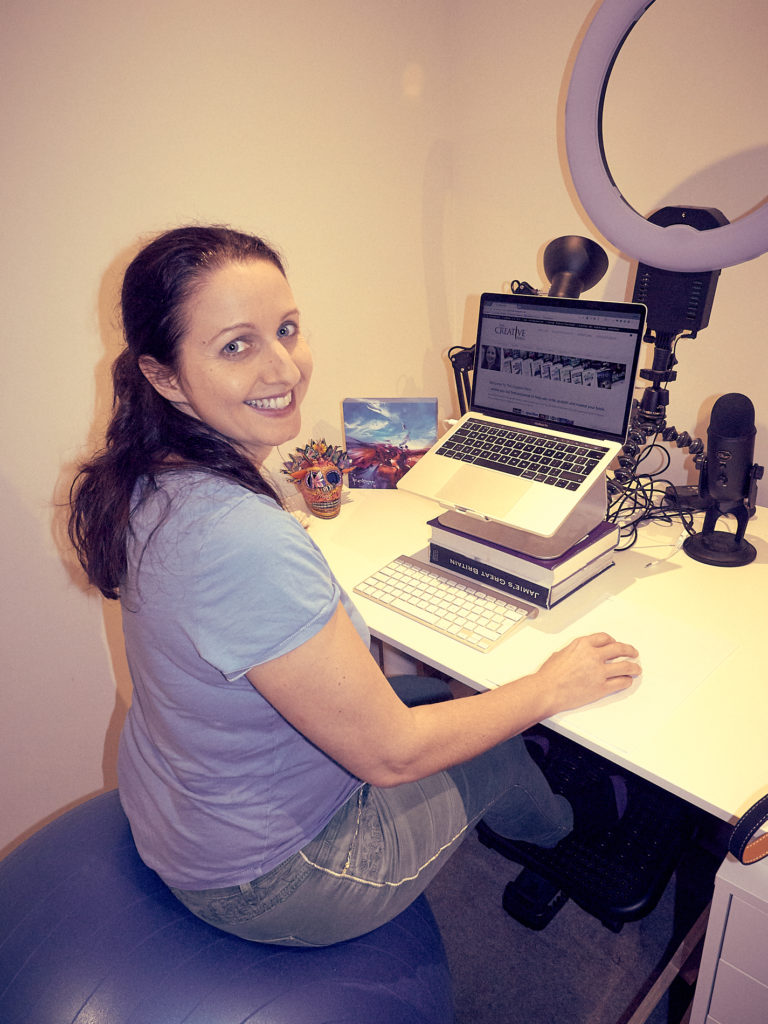Think about your writing position. Do you hunch over? Are your arms in the right position? Is your screen correctly set up? How often do you take movement breaks? Are you getting any lower back pain?

Here are some suggestions that you might want to consider to get your workplace sorted out to be a healthy writer. This article includes details of my own desk set-up, as well as a video from Dr Euan Lawson on his standing desk.

Posture and ergonomic tips and tricks
Laptops can be incredibly bad for your posture. They get it all wrong: the screen is at the wrong height and the angle of your wrists and arms is appallingly bad in ergonomic terms. Getting educated about good ergonomic practice has been shown to help reduce pain and discomfort.
Laptop tips
• Use a riser to bring the laptop up so you are not looking all the way down at it. You could use portable products like StandStand and other options to do this if writing in cafés.
• When possible, use your laptop with an external keyboard.
Check your posture
• Be aware of what the normal shape of your back should be. The rounding off in the lower back is something many people do. Try to practice sitting with a posture where the normal back curves are maintained. A chair with a back support will make a big difference to the time you spend in proper posture.
• Make sure your feet are on the floor or on a footrest.
• Are your shoulders relaxed? Be aware of what your upper body is doing as well.
• When typing, try to keep your forearms parallel with the floor (at right angles to your body).
• When using the keyboard your wrists should be in a neutral position and they should hover above the keyboard to keep them straight.
• Try to avoid resting your wrists or forearms on the edge of the keyboard or table.
• Position your monitor so that it keeps your neck in a neutral position. Usually that will mean the top of the computer screen will be at eye level and you are looking slightly down at it.
• Think about your physical writing style. Holding your mouse in a death grip or banging the keyboard with brutal force are not good habits. Relax.
Vary the work you do in a session
• If you can do some first draft work, then some editing, perhaps some dictation, then the variety is helpful.
• If you are reviewing written documents such as paper copies you have edited up, place them in line with your screen and keyboard. You don't want to be moving excessively or twisting around. You can get simple document holders for just a few dollars that hold paperwork up.
Take regular breaks
• I know it is hard when in the flow, but find out what works for you. A couple of minutes every half an hour with a slightly longer break after an hour will help.
• Do something different in those breaks. Walk a hundred paces or stretch. Get up and move around. Looking at Facebook or Twitter may give you a rest from the writing work but won’t help your body at all.
• There can be a great deal of benefit from taking regular aerobic exercise (the exercise that makes you out of breath rather than pushing weights). It builds core strength, and good muscles equal better posture.
• At the end of it, you could simply stand up. Standing and treadmill desks may not be the answer to all your problems, but they do change up your posture. That change may be enough to give your hands, wrists and forearms the chance to settle down again.
“More words while being unhealthy is self-defeating in the long run. You'll damage your wrists, your arms, even your hands if you don't train for it first. And part of that training is teaching yourself how to stop and start the flow so you can take breaks. Breaks are essential to your long-term health.”
Leah Cutter, The Healthy Professional Writer
Stand-up desks

A systematic review of stand up desks found they had benefits in a number of areas. They weren’t quite as good as treadmill desks, but there were clear advantages over sitting down. People who used a stand-up desk burned more calories and people who were overweight burned even more than those who weren't.
Some studies have also found improvements in tiredness and energy levels even after just a few weeks with a sit-stand desk. Participants reported they felt happier and more comfortable, they were energized, more focused and less stressed using the sit-stand desk. There seems to be some evidence that changes in posture are helpful in reducing drowsiness.
However, a 2016 Cochrane review of the evidence around sit-stand desks did not find high-quality evidence of much of an effect. Part of this might be down to motivations. Individuals given a sit-stand desk at work do not necessarily have any desire to change their behavior. That’s always going to be key in getting people to do things differently. Certainly, many of the studies around this are small scale. If you are enthusiastic, then you may well get a lot of benefit.
There is also some evidence that people who spend all day standing in their occupation are more likely to get some low back pain. It’s probable that a sit-stand desk is going to be best when you use it to mix up and vary your posture throughout the course of the day.
 My Writing Desk Set-Up – by Joanna Penn
My Writing Desk Set-Up – by Joanna Penn
I have a stand-sit solution for my writing desk. When sitting, I use a couple of books and a Mdesign laptop stand to lift my screen and use a Bluetooth keyboard. I sit on a 65cm swiss ball, which I also use for backbends during breaks. Under the desk, I have a footrest.
When standing, for example, when recording a podcast or interview in the picture above, I add a wooden topper from HumbleWorks, which has adjustable shelves so I can have the microphone higher up, or put the keyboard lower down to type.
The ring light is a new addition so I get better lighting for my videos. It's on a Gorillapod stand. The microphone is a Blue Yeti. For more on audio setup, check out this article from my podcast production assistant, Dan Werkhoven.
My Stand Up Desk – By Dr Euan Lawson
Here's a short video from Dr Euan Lawson on his simple and cheap standing desk solution.
Treadmill desk
A treadmill desk is not going to be possible for many people for the simple reason that they don’t have the space at home and the cost can be prohibitive. But there has been some interest in this kind of ‘active workstation' to counteract the sedentary nature of many jobs.
A systematic review of treadmill desks found that they improved cholesterol and glucose levels. People who used a treadmill desk had reductions in their waist circumference and lower blood pressure. It also helped their mental state and they were in a better mood.
There has also been interest in whether the walking causes reductions in the ability to do maths and reading tasks. Some evidence has suggested that is the case. One study in 2015 did find some reduction in cognitive abilities but the differences were minor. There was a clear reduction in typing speed.
Overall, though, these differences seem to be modest and the gains in terms of activity and reduced sedentary time are likely to outweigh them.
“My do-it-yourself treadmill desk has been a lifesaver. I usually walk in the morning when answering emails or doing other mind-numbing tasks.” Abigail Dunard, The Healthy Writer survey
Screen filters and light filtering glasses
As discussed earlier in Chapter 1.8, these have been shown to reduce eye strain and will help reduce headaches. Don’t forget the eye drops to help keep dry eyes and eye strain at bay. Even if you are working at a café, you can slip some drops into your bag.
Ergonomic keyboards and other devices
There is no clear evidence for these kind of devices, but many people feel they get benefit from their use. Some readers also commented on the use of a left-hand mouse (for those who were right-handed). It can take time to get comfortable but being ‘ambi-moustrous’ and being able to use a mouse in either hand may help some repetitive strain patterns.
“Ergonomic keyboards for the win. I switched years ago and can't go back. While it takes some getting used to, I haven't had any problems with wrist strain since.” Joe Baird, The Healthy Writer survey
Working on the move
Writing in cafés is popular for writers. It can be beneficial to get out of the house in order to escape chores and family distractions, find a place for dedicated writing, and also to get some social connections. But if you're slumped in a saggy sofa or hunched over at a table that's at the wrong height, you're going to get back pain.
But wherever you're writing, you can still follow some of the basic principles of good ergonomics. Try to be conscious of the normal curvature of the spine, the position of your forearms and wrists, and keeping your feet on the floor. It may still be feasible to use a riser and an external keyboard with your laptop.
“The idea of just wandering off to a café with a notebook and writing and seeing where that takes me for awhile is just bliss.” J.K.Rowling, who wrote Harry Potter in cafés
Questions:
• 
• Are there ways your workspace could be improved? Could you make space for a standing desk or even a treadmill desk?
• Are you taking enough breaks? How can you ensure that you are?
[ This is an excerpt from The Healthy Writer: Reduce your Pain, Improve your Health, and Build a Writing Career for the Long-Term by Joanna Penn and Dr Euan Lawson. Available now in ebook and print editions.]
 My Writing Desk Set-Up – by Joanna Penn
My Writing Desk Set-Up – by Joanna Penn

Hi, Joanna!
I use a laptop and a monitor on a shelf on my desk at home. At work I use a specific monitor that has a tall stand, so I do not need a stand-up desk while working. Not any books either 🙂
My workspace is quite good, a bit cluttered though. I try to use a good posture while writing but that is not always the case. And, although I have a fitness tracker that alarms me to take a break after an hour or so, I usually ignore it 🙂
Thanks for the great tips.
Marios
Stop ignoring the break reminder!!
I suffered from severe eye strain years ago when I first started working in my home office full time. Staring down at a laptop is quite hard on the eyes, but that problem was easily solved by bringing in an external monitor that’s at eye level. The bigger screen also helps a lot when it comes to editing manuscripts.
Thanks for sharing – eye strain was a serious problem in the Healthy Writer survey.
Due to joint and muscle issues, a standing or treadmill desk isn’t something I can do. I can stand while I write or I can be able to move without severe pain. No-brainer there, lol. So I’ve made mine the best I can ergonomically for sitting. I actually built me desk many years ago because I couldn’t find one at the right height. My laptop is propped up, and I have my ergonomic keyboard on a keyboard tray to get it at the right level. My chair has lumbar support as well.
Last year I also added an external monitor to my setup. My eyes are getting older but I don’t want a bigger laptop. Monitor to the rescue! I also have it set on a warm temperature, and have the free software f.lux installed. It’s a blue light filter that’s customizable. Highly recommend it to anyone who’s sensitive to blue light. I’m incredibly sensitive to it and have filter apps on all my electronic devices.
For ergonomic keyboards, when they first came out, they were truly terrible. They’ve come a long way since then. Anyone who hated one of those early ones, go to an office/computer store or Best Buy and try out some of the new ones. I have a wireless Microsoft one that I adore. I’m a transcriptionist for my day job, so it’s all about how the keys feel for me. The Logitech ones when I last had to buy one were too stiff in the keys to be comfortable for a 100 wpm typist.
Don’t just buy any old mouse either. Go somewhere and play with them, see how they feel in your hand. My Logitech was chosen out of which one best fit my hand
Thanks for the tips 🙂
I have just bought a Yo-Yo (from Amazon) which sits on top of my desk. You can raise it to standing height easily and quickly. So now I write 30 minutes sitting then 30 minutes standing then 30 minutes sitting and so on, using a kitchen timer. I love it because not only do I feel much better physically but I use the in-between times to get a cup of tea, or do a quick chore and other stuff and the break seems to recharge my creativity.
One day I may get a treadmill desk but my current set up is good.
That’s how I work as well – up and down all day!
Thank you Joanna – I’ve been looking forward to these pics!
Great post, great book, and I’ve been sharing the message.
Thanks Henry 🙂
Great tips, Joanna. I think having a comfortable and ergonomic work area is very important for productivity, it really makes a big difference. Plus, the last thing you want after a writing session is an aching back.
Obviously, I’m a big advocate for dictation. 🙂 But I also feel the decline of desktop computers and rise of laptops/tablets has contributed to poor posture and eye strain for many people. Using a larger monitor with your laptop for longer sessions in front of the computer is a good idea if you have the space.
Also, don’t forget the mouse! I developed soreness in two fingers a while back using Apple’s Magic Mouse and switched to a Logitech MX Master – expensive, but significantly more comfortable. There are also vertical mice and trackballs for those brave enough to try something completely different!
Good review! I’m now searching for sit stand desk for my monitor, it is very comfortable thing. I found great variant it ishttps://www.primecables.com/p-357448-cab-mt101-all-primecables-sit-to-stand-adjustable-desk-riser-adr-for-monitor-26-35-wide-black#sku366013Ergo Riser ADR 26. It has 12 available options for height adjustment, reviews are also good. How do you think about this variant?
Hi Joanna,
I would recommend also dictating. I do that as I drive. Do not find standing desks too helpful but using an ergonomic sitting ball is something to consider. Have you tried a recliner?
Liz Basto
Ohh great. Thanks a lot for sharing these tips. All the tips looking really very helpful and worth to follow.
Thank you Joanna for helpful tips. I am using a Varidesk at my current job and although it works if I alternate standing and sitting, I often go for hours forgetting that I need to stand up (or sit). I get back or knee pain as a result. Have you tried a reclining office chairs? What is your feedback?
I found some live plants to bring so much good energy in the space! I have three snake plants on my desk (since there is room, with the desk being 60 inches) and then some African Violets in my windowsill which I can see from my desk. I feel they really do add something extra in the focus department, though it may just be me!